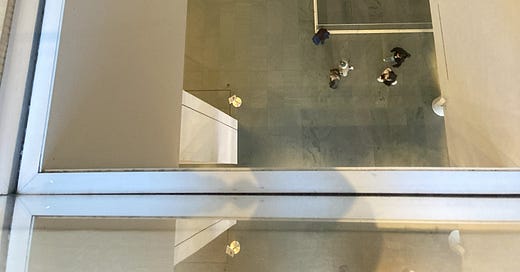Maybe someone some day some will gather a compendium of literary prose descriptions of museums. The list no doubt would include Zola on the Salon: Henry James at the Met; Proust; perhaps yours, truly.
Here’s James Baldwin, at the Museum of Modern Art. Pathetic fallacy or not, the narrative—ruthlessly edited—concerns a breakup between a young gay man and a mature married worman.
“The museum was crowded, full of the stale, Sunday museum stink, aggravated, now, by the damp, rainy, broad-beamed ladies; and they formed, before him, a large, loud, rocking wall, as they shook their umbrellas and themselves and repeated to each other, in their triumphant voices, now awful the weather was. Three young men and two young girls, scrubbed and milky, gleaming with their passion for improvement and the ease with which they moved among abstractions, were surrendering their tickets and passing through the barrier. Others were on the steps, going down, coming up, stationary, peering at each other like half-blinded birds and setting up a hideous whirr, as of flying feathers and boastful wings.”
[…]
“They reached the first of a labyrinthine series of rooms, shifting and crackling with groups of people, with bright paintings above and around them, and stretching into the far distance, like tombstones with unreadable inscriptions. The people moved in waves, like tourists in a foreign graveyard. Occasionally, a single mourner, dreaming of some vanished relationship, stood alone in adoration or revery before a massive memorial—but they mostly evinced, moving restlessly here and there, the democratic gaiety.”
[…]
“They continued their frightening promenade through the icy and angular jungle. The colors on the walls blared at them—like frozen music; he had the feeling that these rooms would never cease folding in on each other, that this labyrinth was eternal.”
[…]
“They passed not far from a weary guard, who looked blinded and dazzled, as though he had never been able to escape the light. Before them was a large and violent canvas in greens and reds and blacks, in blocks and circles, in daggerlike exclamations; it took a flying leap, as it were, from the wall, poised for the spectator’s eyeballs; and at the same time it seemed to stretch endlessly and adoringly in on itself, reaching back into an unspeakable chaos. It was aggressively and superbly uncharming and unreadable, and might have been painted by a lonely and bloodthirsty tyrant, who had been cheated of his victims.”
James Baldwin, Another Country (New York: Vintage, 1993), pp. 401-405.
WOID XXIV-45a
May 23, 2025




